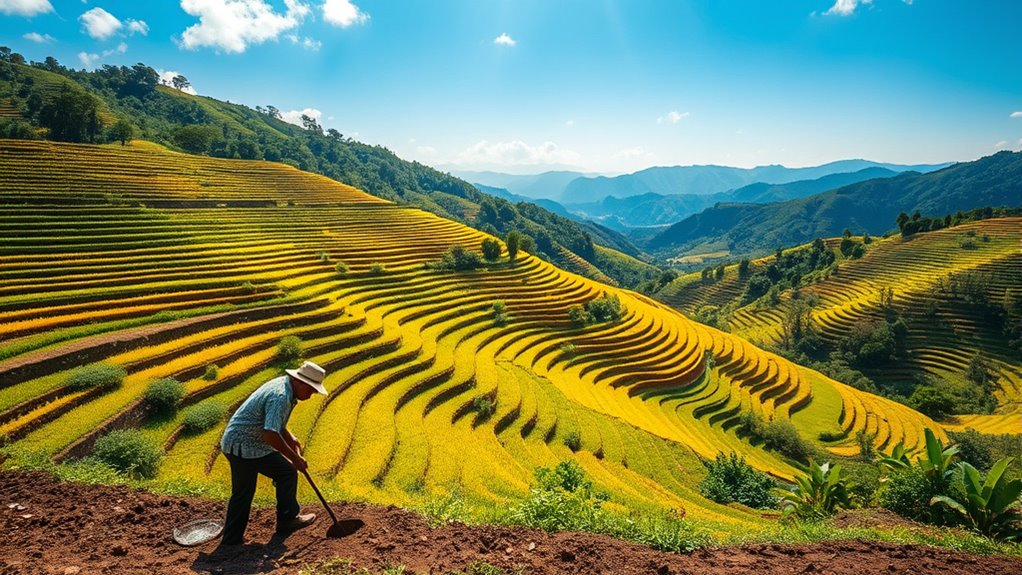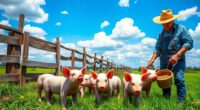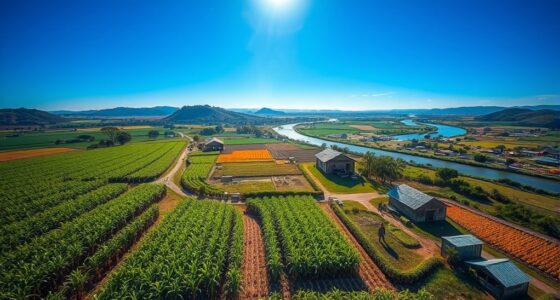Terrace farming lets you transform steep slopes into flat platforms for growing crops. It prevents soil erosion while maximizing arable land. By using techniques like contour farming or raised-bed terraces, you can enhance water retention and improve crop yields. You'll enjoy sustainable agriculture, diverse plantings, and better food security. However, it's important to be aware of challenges like soil fertility loss and maintenance issues. Explore more about its benefits and methods to get the most from your efforts.
Key Takeaways
- Terrace farming transforms steep slopes into flat platforms, maximizing arable land and preventing soil erosion.
- It offers benefits like improved crop yields, water conservation, and stable growing environments.
- Techniques include contour farming, bench terraces, and paddy terracing, tailored to specific slope conditions.
- Initial construction involves careful groundwork, shaping, and the use of specialized equipment for efficiency.
- Challenges include limited land area, maintenance workload, and potential uneven moisture distribution affecting irrigation.
Definition and History of Terrace Farming

Terrace farming is an innovative agricultural practice that transforms steep slopes into flat platforms for crop cultivation. This method not only maximizes arable land in hilly areas but also plays a vital role in soil conservation by slowing down water runoff and retaining moisture.
Originating in ancient civilizations like Mesopotamia and the Inca Empire, terrace farming has spread globally, adapting to various landscapes. It showcases cultural significance, preserving traditions passed down through generations.
You'll find this practice in regions such as the Andes, Southeast Asia, and the Mediterranean, highlighting its diverse applications. By understanding its history and definition, you appreciate how terrace farming contributes to sustainable agriculture and environmental integrity.
Types of Terrace Farming
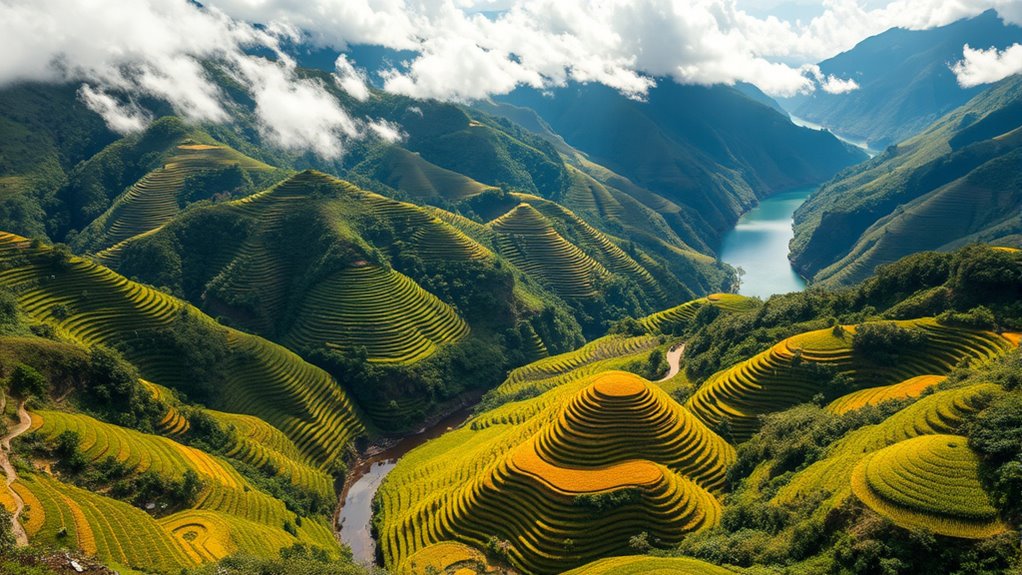
When you explore the various types of terrace farming, you'll find methods specifically designed to adapt to different slopes and climates.
Contour farming builds terraces along contour lines to prevent erosion and retain moisture.
Contour farming creates terraces that follow the land's natural shape, effectively preventing erosion and conserving moisture for crops.
For steep slopes, bench terrace farming conserves water by trapping and slowly releasing it.
Stepped terrace farming is ideal for gentle slopes, effectively controlling erosion and retaining moisture.
Raised-bed terrace farming enhances drainage and soil aeration, benefiting well-drained crops.
Lastly, paddy terracing retains water for crops like rice, ensuring they thrive in flooded fields.
Each type plays a crucial role in optimizing agricultural practices while addressing the challenges posed by varied landscapes.
Benefits of Terrace Farming
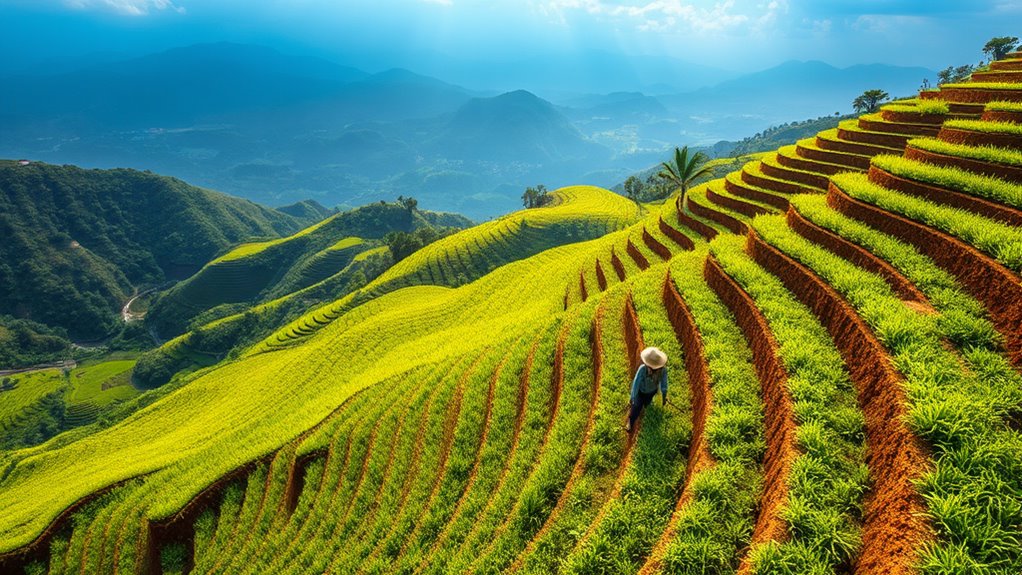
While many farming techniques aim to maximize productivity, terrace farming stands out for its remarkable benefits in conserving soil and water.
By trapping soil on each terrace level, it effectively prevents erosion and maintains soil fertility, reducing nutrient loss. This method creates stable growing environments, allowing you to grow crops more intensively while minimizing landslide risks.
Additionally, terrace farming conserves water by promoting absorption rather than runoff, leading to less pollution. You'll notice improved crop yields and food security, as the terraces support diverse plantings and better moisture management.
Techniques and Construction of Terraces
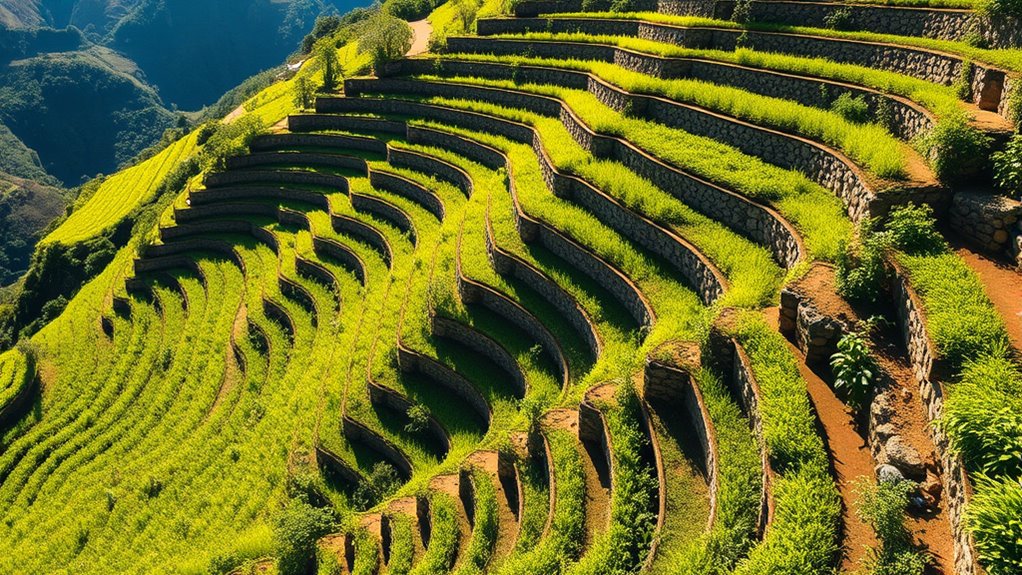
Constructing terraces involves a series of precise techniques that ensure stability and efficiency in hilly regions.
You'll start with initial groundwork, making passes along the terrace centerline about 4 to 6 inches deep. Adjust the gang tilt to move soil from the sides into the terrace base.
For shaping, set gangs at 12 or 13 inches, increasing by 1 to 1½ inches with each pass. Finish with a final pass at 15 inches to smooth the slopes.
You can choose from various techniques, such as broad-base, grassed back-slope, or bench terracing, depending on the slope's steepness.
Specialized equipment like the AMCO Terracing Plow and disc harrows will streamline your construction process, making it efficient and effective.
Regional Applications of Terrace Farming
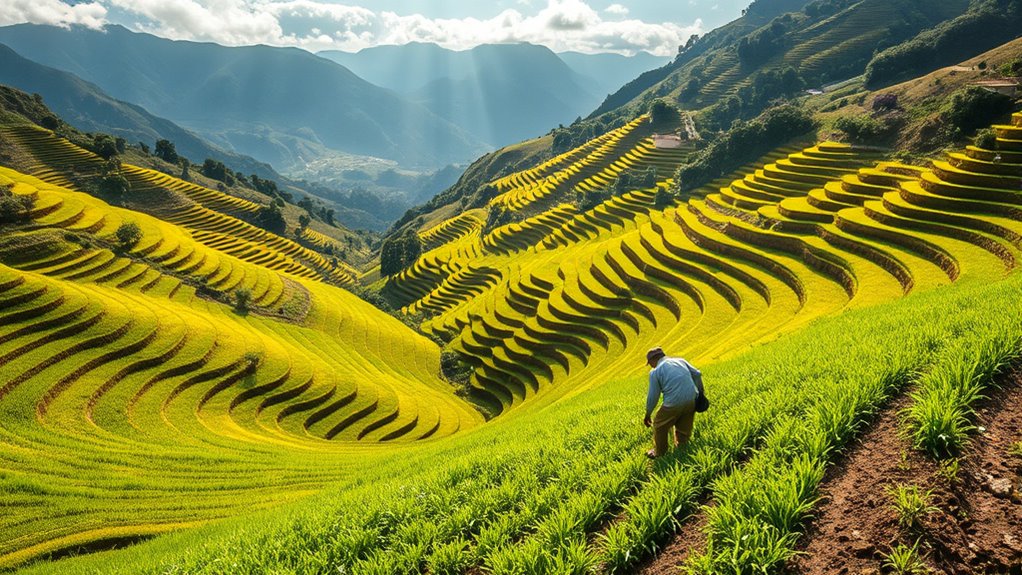
Terrace farming plays a crucial role in various regions around the world, adapting to the unique challenges of hilly terrains.
In Asia, countries like China and the Philippines rely on terraces for rice cultivation. Southeast Asia, especially Vietnam and Indonesia, extensively uses terracing for diverse crops.
The Andes in South America showcases ancient terracing techniques, notably from the Inca civilization.
In Africa, regions like West Africa have practiced terracing for centuries, enhancing agricultural productivity.
Meanwhile, the Mediterranean Basin employs terracing for olives and grapes.
These practices not only boost crop yields and food security but also preserve cultural heritage and foster community engagement, making terrace farming a vital aspect of sustainable agriculture worldwide. Additionally, the economic benefits of terrace farming can include increased job opportunities and improved local economies through sustainable agricultural practices.
Challenges and Limitations of Terrace Farming
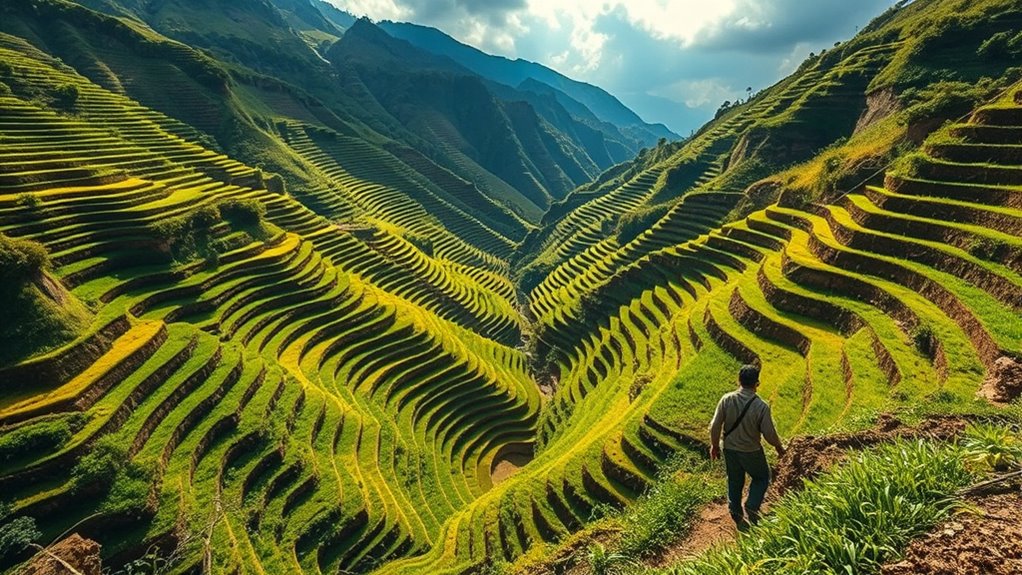
Although terrace farming offers numerous benefits, it also comes with significant challenges that can hinder its effectiveness. Limited land area means you're often dealing with small, fragmented holdings, making it tough to maximize production.
Erosion and soil fertility loss can occur during construction, while maintaining taller terrace walls adds to your workload and risk of collapse. Additionally, soil compaction from construction equipment hampers root growth and water absorption.
You might struggle with access to markets and high infrastructure costs, especially in remote areas. Labor shortages can impede management, and the lack of modern techniques keeps you from innovating.
Finally, altered water flow can lead to uneven moisture distribution, complicating irrigation and impacting crop health.
Sustainable Practices in Terrace Farming
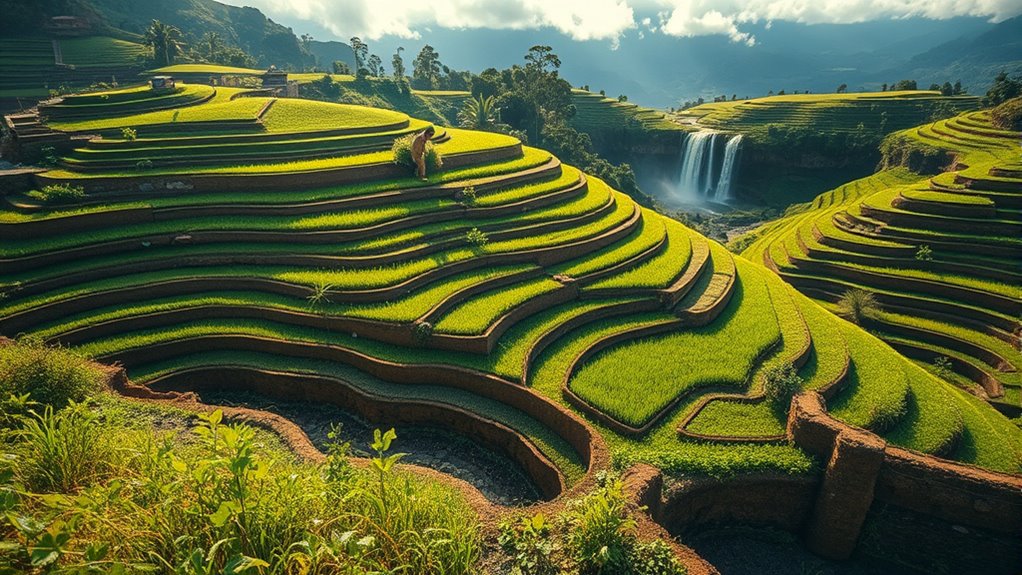
While terrace farming presents challenges, it also offers a pathway to sustainable agricultural practices that enhance productivity and protect the environment.
By breaking slopes into levels, you reduce soil erosion and maintain topsoil, which is vital for crop growth. Terraces also act as natural water reservoirs, managing water effectively in areas with erratic rainfall. This ensures better crop yields and promotes biodiversity by allowing diverse planting.
Additionally, terrace farming plays a crucial role in climate change adaptation, helping to prevent landslides and improve soil health.
Frequently Asked Questions
How Do Terrace Farming Practices Vary by Region?
Terrace farming practices vary significantly across regions, influenced by local climate, topography, and cultural practices.
In wet climates, you might grow rice, while dry areas favor cereals. You'll notice different irrigation methods, like flood irrigation or rainwater harvesting, tailored to water availability.
Soil conservation techniques, such as terracing, help prevent erosion, and crop selection reflects regional preferences and market demands, ensuring your farming practices align with local conditions and needs.
What Crops Are Best Suited for Terrace Farming?
When you consider crops for terrace farming, think about grains like wheat, rice, and maize, which thrive in varied climates.
Legumes, such as pulses and oilseeds, also do well.
For fruits and vegetables, you can grow apples, potatoes, and grapes.
Specialty crops like saffron or herbs can thrive too.
The key is to choose varieties that match your local climate and the specific conditions of your terraced fields.
How Do Terraces Impact Local Wildlife and Ecosystems?
Terraces impact local wildlife and ecosystems by creating diverse habitats that support various species.
When you incorporate native plants, you provide food and shelter for wildlife, enhancing biodiversity.
Terracing also reduces soil erosion and slows water runoff, which helps nourish crops and maintain soil quality.
What Are the Economic Implications of Terrace Farming?
Terrace farming significantly impacts your local economy. By increasing crop yields, it boosts your income through both self-consumption and sales.
You can sell surplus produce in local markets, creating more economic opportunities. This method also allows you to cultivate land that was previously unsuitable, expanding your agricultural potential.
With reduced soil erosion and water conservation, your farming practices can become more sustainable and profitable over time, ensuring long-term viability for your community.
How Can Technology Improve Terrace Farming Methods?
Ever wondered how technology can transform your terrace farming methods?
By integrating precision agriculture software, you can analyze soil health and weather patterns to optimize your planting.
Drones and satellites allow you to monitor crop growth in real-time.
Smart irrigation systems adjust water distribution automatically, preventing waste.
Plus, using advanced sensors helps you manage soil effectively.
With these tools, you'll enhance productivity and sustainability, making your farming efforts more efficient and rewarding.
Conclusion
In the grand tapestry of agriculture, terrace farming stands as a resilient stitch, weaving sustainability into the landscape. By embracing this technique, you're not just cultivating crops but nurturing the earth itself. Each terrace symbolizes hope, transforming steep hillsides into thriving gardens. As you plant your seeds, remember that you're part of a legacy that bridges the past and future. So, let's elevate our farming practices, ensuring that the beauty of our land flourishes for generations to come.

